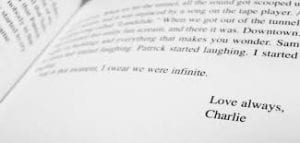
The Fort Pitt Tunnel that Charlie goes through. This symbolizes him getting to see the light at the end of the tunnel, and his character development blossoming throughout the novel.
Here I am writing my second blog post, and all I can say is that I don’t want this book to end. Ever. I rarely read books out of pure enjoyment because usually, they don’t resonate with me. But the perks of being a wallflower by Stephen Chbosky has changed my opinion and has reinspired me to search for good books again. While there are many enjoyable things that I could analyze about this book, the one thing I am excited to delve further into is the book’s symbolism and how it ties into Charlie’s, the main character’s, transformation: this is, after all, a coming of age story. I haven’t finished the book yet, but so far Charlies has been to the famous Fort Pitt tunnel in Pennsylvania twice. For one of the times, Charlie is just in the car admiring his crush and friend Sam. But the second time around he is the one in the back of the truck. Charlie raises his arms high as the truck drives magnificently to the end of the tunnel. I think that Chbosky was playing on the phrase “the light at the end of the tunnel,” which is cheesy but still ties into Charlie’s journey in the book. An example of the tunnel correlating with Charlie’s character growth is when he says “When we hit the tunnel, all the sound got scooped up into a vacuum… Lights on buildings and everything that makes you wonder. Sam sat down and started laughing. Patrick started laughing. I started laughing. And in that moment, I swear we were infinite” (Chbosky 26). This moment reveals that Charlie finally feels happy and as if life is worth living for, almost as if he sees the light at the end of the tunnel. At the beginning of the novel Charlie is very much isolated from the world and is saddened; now, he is blossoming and feels infinite, displaying the tunnel’s effect on him.

Charlie writing that he feels infinite when he goes through the tunnel with Sam and Patrick. The beginning of his character development and him breaking out of his shell.
Like I said earlier, Chbosky has done a really nice job on this novel and there’s not much that I would disagree with. There are aspects of the book that I enjoy more than others, though. For instance, the novel’s point of view or how the book is actually organized is genius in my opinion. The whole book is actually a series of letters from Charlie where the reader is addressed as “Dear Friend.” Charlie is writing letters to a person who may understand what he is going through, and he shares his innermost thoughts that a reader wouldn’t get if the novel was in a third person point of view. This is Charlie’s story after all, and the book’s focus is on how he changes as a person, and it is amazing that the readers get to witness it first hand through his eyes. Also, the letters or the way Chbosky chose to organize the novel is structured in a way that lets readers take something away from Charlie and it gives readers an opportunity to look at Charlie as a mentor of sorts. Charlie states in his letters that if he can survive what he went through, that the reader can too. The letters form a personal bond with the reader and give anyone reading, including me, an immense amount of hope. I felt like I knew Charlie personally and that he was there for me even if no one else is. I really like that Chbosky formatted the book this way with a personal glimpse of Charlie’s world. He sees the world differently, and it puts everything in my own life into perspective.
If you ever do get a chance, please read this book! You will join Charlie on his rollercoaster of life and you will root for him through his happy and dark times.
Till the next blog post,
Shruthi
